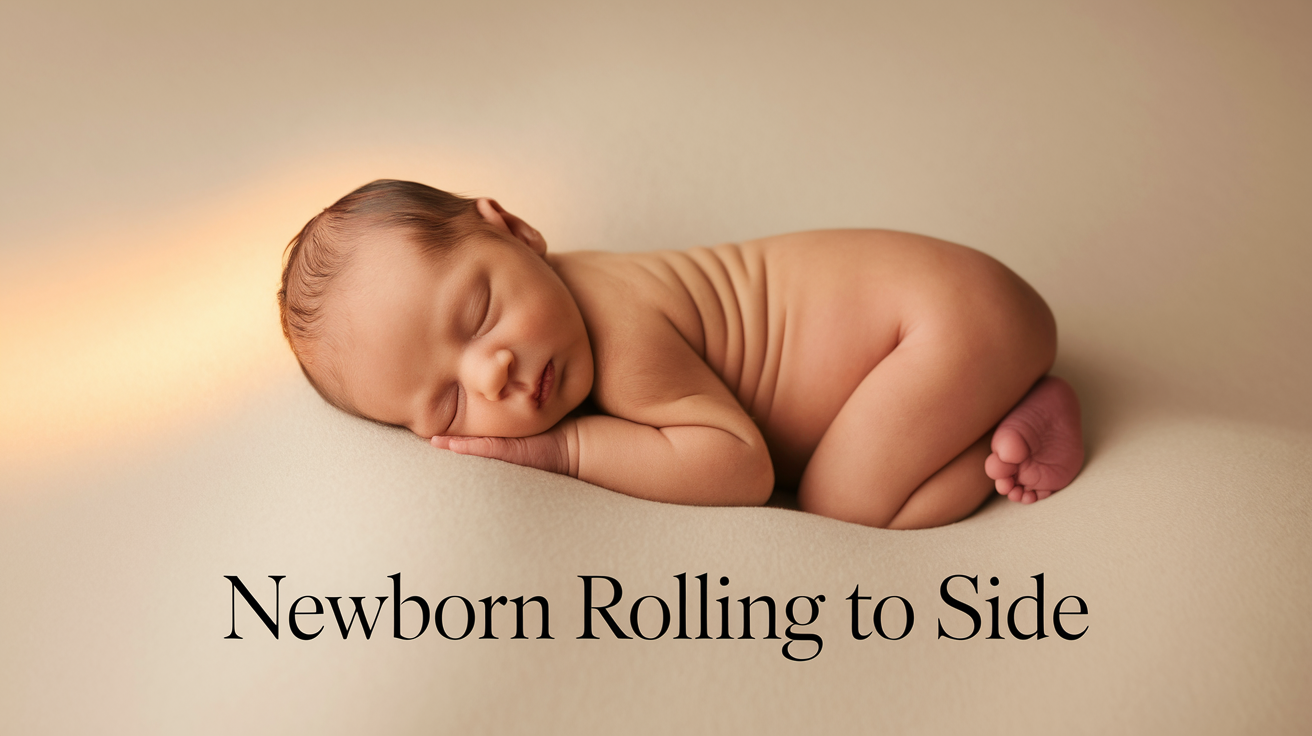
When you bring your new baby home, sleep becomes a big deal—both for them and for you. Knowing how to position your newborn during sleep safely is one of the most important things you’ll learn as a new parent.
Babies spend up to 17 hours a day sleeping, which means getting their sleep position right is super important for their safety and development. The way your little one sleeps can help prevent serious risks and give them the best start in life.
A newborn’s sleep cycle is only about 50-60 minutes long, compared to an adult’s 90-minute cycle. This is why babies wake up so frequently.
Proper sleep positioning isn’t just about comfort—it’s about keeping your baby safe and helping their growing body develop correctly during those precious sleeping hours.
Is it Normal for the Newborn to Roll to the Side?
Yes, it’s completely normal for newborns to roll to their side occasionally. This natural reflex, called the “newborn curl,” happens when babies instinctively assume a fetal-like position they were used to in the womb.
Most babies can roll from their back to their side within the first few weeks, though consistent rolling (back to tummy or tummy to back) typically develops around 4 months.
While side-rolling is normal, always follow safe sleep guidelines:
Place the baby on its back in a flat, firm sleep space without pillows, blankets, or toys.
Has your little one started showing signs of rolling? Remember, each baby develops at their own pace!
Newborn Curl vs. Rolling Over
The newborn curl is different from rolling over. When babies curl, they make a slight shift to the side without actually changing their basic position from back to stomach.
Key differences include:
- The curl is a partial movement, while rolling is a complete position change
- Curling uses different muscle groups than the coordinated effort needed for rolling
- Rolling requires intentional movement and coordination that develops months later
Parents should understand that the newborn curl is not a milestone like rolling over, which typically happens between 3 and 6 months of age when babies develop stronger neck and core muscles.
Why Your Newborn Might Be Rolling to the Side?
-
Natural Reflexes and Movement: The “newborn curl” reflex causes babies to tuck into a fetal position they were accustomed to in the womb. This sideways positioning is instinctive and completely normal.
-
Swaddling or Sleep Positioning: How you swaddle or position your baby may influence their tendency to roll. Some babies naturally shift to find their most comfortable position.
-
Muscle Development Milestones: Early rolling movements can indicate healthy neck and core muscle development, even before intentional rolling begins at around 4 months.
-
Reaction to Discomfort or Gas: Babies sometimes roll to their side to relieve gas or digestive discomfort. This position can naturally help ease tummy troubles.
Can Newborns Sleep on Their Sides?

While the newborn curl is natural, doctors and health experts do not recommend sleeping your baby on its side.
The American Academy of Pediatrics strongly advises that babies should always be placed on their backs to sleep—not their sides or tummies.
This position has been proven to dramatically reduce the risk of Sudden Infant Death Syndrome (SIDS) and other sleep-related dangers.
Safety Concerns with Side Sleeping
Side sleeping poses several risks for newborns that parents should be aware of:
- Increased risk of SIDS compared to back sleeping
- Possibility of rolling onto their stomach, which can restrict breathing
- Potential airway compression if the baby’s head turns awkwardly
- Higher chance of rebreathing exhaled air, which contains less oxygen
The “Back to Sleep” campaign (now “Safe to Sleep”) has helped cut SIDS rates by more than 50% since 1994. This simple change—placing babies on their backs—has saved thousands of little lives!
When Do Babies Start Rolling Over?

Rolling over is one of the most exciting early milestones in your baby’s development trip. While the newborn curl might look like a small step toward rolling, true rolling is a separate skill that develops after your baby gains more strength and coordination.
Most babies master this movement between 3 and 6 months, though every baby follows a unique timeline—some may roll earlier, while others take a bit longer.
Age and Developmental Milestones
Most babies begin rolling over between 3-6 months of age, though individual timelines vary:
- Around 3-4 months: Many babies first roll from tummy to back
- By 5-6 months: Most can roll from back to tummy, which requires more strength
- Some babies might skip stages or develop their rolling method
Watch for these ready-to-roll signs:
- Pushing up higher during tummy time
- Rocking from side to side while on their back
- Showing increased interest in reaching for toys just beyond their grasp
- Successfully turning their head and shoulders when lying down
The Importance of Muscle Development
Tummy time plays a crucial role in helping your baby build the muscles needed for rolling:
- It strengthens the neck, shoulder, and arm muscles needed to push up
- Daily practice helps develop the core strength required for rolling
- Even 3-5 minutes several times a day makes a big difference
Rolling typically follows these stages:
- First accidentally rolling (usually tummy to back)
- Purposeful tummy-to-back rolling as they gain control
- The harder back-to-tummy roll, which requires stronger abdominal muscles
- Finally, rolling both ways becomes a fun new way to explore their world!
Remember, “You can’t rush a roll—your baby’s body will know when it’s ready to take that tumble!”
Swaddling and Side Rolling

Swaddling is a wonderful technique that many parents use to help their babies sleep better. This ancient practice involves wrapping your baby snugly in a thin blanket, creating a womb-like feeling that can calm fussy babies and promote longer, more peaceful sleep.
However, as your baby grows and begins to show signs of rolling, your swaddling approach needs to change to keep them safe during sleep.
Intentional vs. Unintentional Rolling in Newborns
| Aspect | Intentional Rolling | Unintentional Rolling |
|---|---|---|
| Age of Onset | Typically begins around 4-6 months | May occur from birth to 2 months |
| Muscle Control | Shows deliberate muscle coordination | Lacks coordinated muscle control |
| Head Position | Head leads the rolling movement | Head may move passively with the body |
| Body Movement | Smooth, coordinated sequence | Often jerky or reflexive |
| Preparation | Shows effort before rolling (e.g., pushing with arms) | No preparatory movements |
| Repetition | Can repeat the movement when desired | Happens randomly or sporadically |
| Facial Expression | Often shows concentration or satisfaction | No particular facial expression |
| Trigger | Self-initiated or motivated by desired object | May be triggered by startle reflex or positional changes |
| Direction Control | Eventually able to roll both ways (back to front, front to back) | No directional control |
| Developmental Significance | Important milestone showing motor development | Normal newborn movement pattern, not a milestone |
Note: True intentional rolling is a developmental milestone typically achieved between 4 and 6 months. What appears as rolling in newborns (0-2 months) is usually the result of reflexes or accidental movement rather than purposeful motor control.
The Role of Swaddling in Preventing Side Rolls
Swaddling works as a gentle reminder to stay on their back by:
- Limiting arm and leg movement that might trigger rolling
- Creating a snug wrap that discourages wiggling to the side
- Providing boundary awareness for babies still learning about their bodies
When it’s time to transition from swaddling, try these safer alternatives:
- Sleep sacks with arms out
- Transitional swaddles that free the arms but still provide torso security
- Gradually unwrap one arm at a time to help baby adjust
How to Handle Sleep Disruptions from Rolling?

When your baby learns to roll over, it often becomes their favorite new skill—even at 2 AM!
This exciting milestone can temporarily disrupt sleep patterns, as babies may wake themselves up while practicing rolling or become frustrated when they roll but can’t get back to their preferred position.
While these disruptions can be challenging for tired parents, they typically pass as your baby becomes more proficient at rolling both ways.
Managing Nighttime Rolling
Once your baby starts rolling during sleep times, it can cause some unexpected wake-ups:
- Babies often wake startled or crying after rolling onto their tummies during sleep
- Some get stuck in positions they don’t like and need help rolling back
- Sleep regression is common during this developmental milestone
Try these approaches to minimize disruptions:
- Continue placing baby on their back at the start of sleep
- If they roll to their tummy and are upset, gently roll them back
- Once they can roll both ways confidently, you don’t need to flip them back unless they’re distressed
- Use a video monitor to check if they truly need intervention or are just practicing
Helping Your Baby Adjust to Rolling
Supporting your baby’s rolling development during the day can lead to better sleep at night:
- Provide extra tummy time to strengthen the muscles needed for smooth rolling
- Place toys slightly out of reach to encourage rolling toward them
- Practice guided rolling during diaper changes or playtime
Remember, this is a learning process:
- Some babies roll one way for weeks before mastering both directions
- Celebrate small progress to build confidence
- Stay patient—most babies need 2-3 weeks to get comfortable with their new skill
As one wise pediatrician puts it, “Daytime practice makes for nighttime peace. The more comfortable they become with rolling during awake time, the less it will disrupt their sleep.”
The Transition to Safe Sleep After Rolling

Once your baby starts rolling consistently, you’ll enter a new phase of safe sleep practices. This transition can be worrying for parents who’ve carefully followed the back-sleeping guidelines since birth.
While the “back to sleep” rule remains important for how you initially place your baby down, the rules do change a bit when your baby can roll on their own.
Learning how to navigate this transition will help keep your baby safe while respecting their growing independence and mobility.
When Can Babies Sleep on Their Stomach?
The guideline for when babies can sleep on their stomach is straightforward but important:
- Babies should ONLY sleep on their stomach if they can roll there completely on their own
- Most babies develop this ability between 4-6 months of age
- They must be able to roll from back to stomach AND from stomach to back independently
Safety considerations include:
- Always place baby on their back to start sleep, even if they immediately roll over
- Once they roll themselves to their tummy, it’s generally safe to let them stay that way
- If your baby can only roll one way (usually back to tummy first), continue to roll them back
Ensuring a Safe Sleep Environment
When your baby starts rolling, these safe sleep practices become even more critical:
- Remove all pillows, blankets, stuffed animals, and bumpers from the crib
- Use a firm mattress with a fitted sheet only
- Make sure sleepwear isn’t too loose or restrictive
- Keep the room at a comfortable temperature (68-72°F) to avoid overheating
Prevent SIDS and other sleep risks by:
- Transitioning out of swaddles completely once rolling begins
- Using a sleep sack that allows free arm and leg movement
- Ensuring the crib meets current safety standards with proper spacing between slats
- Continuing room-sharing (not bed-sharing) for at least the first 6 months, ideally 12 months
As your pediatrician might say, “A rolling baby is a growing baby—our job is to give them a safe space to practice this new skill, day and night.”
When to Call the Pediatrician?

If your newborn rolls to their side while sleeping, it’s typically normal behavior. However, contact your pediatrician if you notice breathing difficulties, unusual color changes, or if rolling seems accompanied by discomfort.
While most side-rolling in newborns is harmless, consult a doctor if it occurs with excessive startling, unusual muscle stiffness, or if your baby cannot be positioned on their back for safe sleep.
Always follow the AAP’s safe sleep guidelines—back sleeping remains safest for newborns, even if they naturally roll. Trust your parental instincts, and don’t hesitate to seek professional advice when concerned.
Conclusion
When your newborn rolls to their side while sleeping, it represents a natural developmental stage from their time in the womb.
This article explores the newborn curl, explaining how it differs from true rolling (which occurs at 3-6 months) and why back sleeping remains crucial for SIDS prevention.
We covered swaddling safety, when to transition out of swaddles, and how to manage sleep disruptions when rolling begins.
The trip from newborn curl to independent rolling marks significant developmental progress. Parents should always place babies on their backs to sleep, provide plenty of tummy time during awake hours, and create a safe sleep environment free of loose bedding.
Once babies can roll independently in both directions (usually at 4-6 months), they may choose their sleep position.
Throughout this trip, consistent safe sleep practices, alongside supporting natural development, keep your growing baby safe and thriving.
